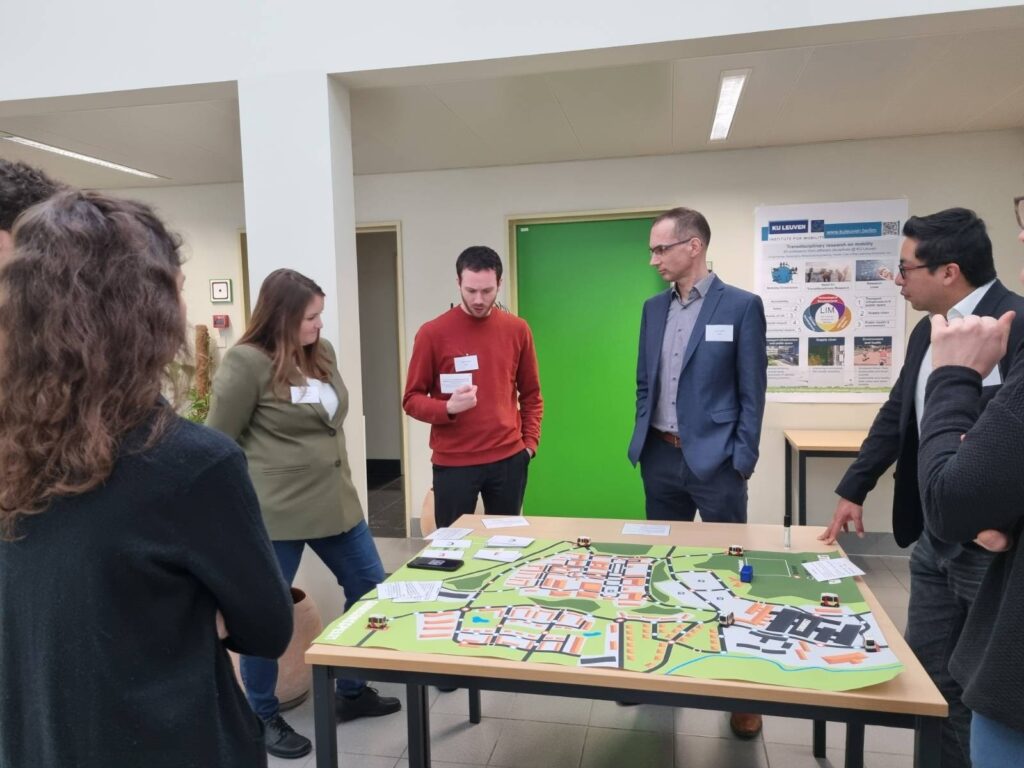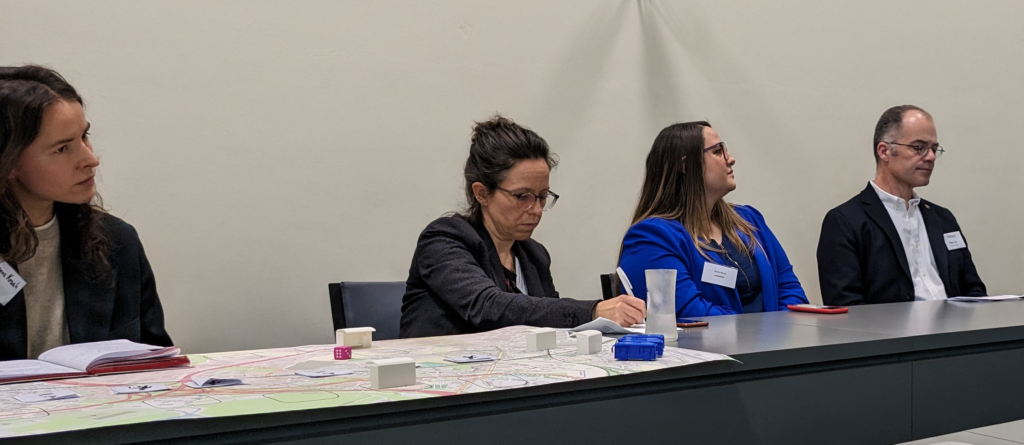Conference Report
On February 23rd, 2023, the CATAPULT, SmartHubs and JUSTICE Conference took place in Brussels. While SmartHubs and JUSTICE will continue their work until mid 2024, for CATAPULT, the conference marked the end of the project.
In the one-day event, the projects presented their approaches on making the future mobility system more accessible and inclusive. We saw a variety of methods and tools that are aimed at developing and co-creating new solutions together with different (vulnerable) user groups and stakeholders.
CATAPULT (Nora Spiegel, AustriaTech & Joshua Bronson, RI.SE)
CATAPULT Policy Recommendations
„Critical for a few, essential for many, and good for all“ – CATAPULT dedicated its work to identify the needs and barriers, certain user groups – children, older persons and people with disabilities – might be facing when automated mobility solutions will be implemented.
The results of the CATAPULT projects cover various aspects of a journey with an automated shuttle, e.g. trust, acceptability, physical accessibility, information management, comfort, communication as well as potential use cases.
In the Q&A session, we discussed in what way the results can be scaled up to a conventional passenger bus. To a large extent, the results have to be interpreted in the context of the shuttle that is essentially a prototype. Since an on-board operator is still a legal requirement, sense of security might reflect this pilot setup and not the future scenario with no safety driver present.
Nevertheless, results on aspects like accessibility of the vehicle and the surrounding infrastructure, as well as replacement for the „informal“ services and support that a driver is currently providing (e.g. solving conflicts and providing information) will be important for all types of automated busses.
Furthermore, the user groups involved in CATAPULT are already facing various problems in the current mobility systems. Some examples for this are the lack of toilets at bus stops, complicated ticketing systems or too little time for changing bus lines. A lot of these barriers will not be overcome by a technological solution like an automated shuttle.

In an interactive session, the conference participants were able to experience the awareness version of the CATAPULT Serious Game that was developed to raise awareness of the barriers that the project’s user groups might face when using automated shuttles. The response from the participants was very positive. The game serves the purpose well and allows empathizing with people who might have different experiences when using public transport than oneself. This complies with the feedback the CATAPULT project team received during the test sessions with different stakeholders and experts.
SmartHubs (Imre Keserü, Vrije Universiteit Brüssel)
SmartHubs examines MobilityHubs and looks at the acceptance of new technology and their impact on society. Their main objective is to assess whether a co-designed, user-centric development can enable mobility hubs to act as a game changer towards inclusive sustainable urban mobility and accessibility.
For the consortium, „Smart“ is more than technology and innovation, it also means inclusiveness, accessibility and co-design. „Mobility hub“ is understood as a physical location, where different shared transport options are offered at permanent, dedicated and well visible locations.
Innovative participatory tools that facilitate a co-designed and user-centric development were developed and applied in the project. Two elements were presented at the conference:
The SmartHubs integration ladder allows standardized benchmarking and the setting of development goals for hubs. The ladder evaluates factors along three dimensions: Level of physical integration of the mobility hubs, level of digital integration of the mobility hubs & level of democratic integration of mobility hubs.
In the interactive session, SmartHubs introduced the participants to their stakeholder involvement tool „MAMCA“ (Multi-Actor Multi-Criteria Analysis). The tool allows to evaluate the impact of different SmartHub designs on the priorities of different stakeholders. The feedback from the participants regarding the tool was very positive. It was perceived as really helpful in quantifying and visualizing different priorities.
During the Q&A session, the aspect of digital resilience was discussed. Here, SmartHubs refers to the results of the INDIMO project. They found that concerns about data and financial information is a factor that currently stops people from using shared mobility service. One of the policy recommendations of INDIMO addresses this by recommending to present the information about data use in a simple way that everybody can understand.
Another question that was raised was how the project defined „Vulnerable User Groups“, since the literature is unclear about this term. This was indeed also a difficult process for the SmartHubs project, since there are also intersectional aspects to consider. Therefore, they see universal design as a crucial aspect for inclusivity.
JUSTICE (Arthur Nihoul, UC Louvain)
Intra-urban accessibility is not the same for everyone because public spaces, buildings and public transport systems are not designed to be fully inclusive. JUSTICE is therefore researching on intra-urban accessibility with a focus on people with physical and visual disabilities.
The project follows a multi-step approach. First, constraints and indicators needed for developing an accessibility model were identified. This already showed that the main share of stops in Brussels is currently not accessible for people with mobility constraints.
The model was then evaluated with participants from the target groups, following a qualitative approach: The participants shared their mobility constraints in advance. This information was given to the accessibility model that then suggested a route that should be accessible for a person with certain abilities. In a second step, the participants made the journey according to the model, accompanied by a researcher. The aim of this qualitative approach was to identify, if there is a divergence between the model and reality.
With their multi-step approach, JUSTICE identified potential improvement to their model, e.g., refining constraints to reach with more precision the requirements needed for persons with reduced mobility and adding additional constraints that have not been considered yet.
JUSTICE sees potential in their tool to improve the experience of using public transport for people with reduced mobility by suggesting accessible routes. This can also attract new people that at the moment shy away from using public transport because they consider it as too complicated.
In the Q&A session, the aim of the model and its application was addressed. One major novelty is that for the first time, there is a tool that shows accessibility and inequality of public transport at city level.
Panel Discussion (Imre Keserü, Vrije Universiteit Brüssel & Martin Holmberg, RI.SE)
The highlight of the conference was the panel discussion in the afternoon, where experts of the field shared their knowledge and experience.
Together with
- Suzanna Kraak (Policy Officer, European Commission)
- Delphine Grandsart (Research Officer, EPF)
- Giulia Renzi (Project Manager, ICOOR)
- Pedro Homem de Gouveia (Senior Policy & Project Manager, POLIS)
we discussed the key issues that need to be considered for making automated mobility services more inclusive and the role of research and policy.

Coming from different backgrounds, the panellists all provided different perspectives regarding the key issues to make automated mobility services more inclusive.
The uncertainty of the future is something that needs to be considered in mobility research as well as governance.
“Climate Change and Population Ageing are two key structural trends that will shape our future. They have profound economic, social, and political implications for the future of cities, and for the governance of all things urban, including urban mobility.” – Pedro Homem de Gouveia (POLIS)
Furthermore, co-creation processes need to go further than simply engaging with different user-groups. It is crucial to involve people, listen to what they need, want and desire and to use experience as an enabler for inclusiveness. Processes for co-creation need to be set up in a way that everybody feels comfortable.
“The three key aspects for making mobility more inclusive are: involvement, listening and experience. We should involve people, not just engage them. We should listen carefully to them and start from their experience. Co-creation processes need to be comfortable for everyone.” – Giulia Renzi (ICOOR)
Moreover, it is necessary to shift the perspective and start developing technology and new services from what users need and want. A societal perspective on new technology needs to be integrated from the start of a development process.
Research and innovation must also take responsibility. Considerations about how the services will be useful and how they will impact different user groups need to be made at an early stage.
“Responsibility for inclusivity starts with research and innovation. Societal needs should be the starting point. Co-creation, co-design and universal design are essential for putting research and innovation to use for society.” – Suzanna Kraak (EC)
Furthermore, the scope of accessibility was discussed. It became evident, that accessibility needs to go beyond physical components and include accessible information as well.
The second part of the discussion focused on best practices and challenges to approach different stakeholders. One main message was that it is important to include user and stakeholder groups from the beginning and to shift from a technological push to an user-centric approach. Research and innovation on automated mobility needs to become more trans- and interdisciplinary and a common language and understanding must be established. This is also important when it comes to communicating research results, e.g., policy recommendations, to public authorities, cities, transport planners, etc.
“Research and innovation need to shift from a technology-focused approach to one with humans in the centre. Also, it is not enough to produce long reports, but more practical, useful outcomes are required that are available and accessible to a non-scientific community.” – Delphine Grandsart (EPF)
Finally, potential trade-offs between social, economic and ecological factors were discussed. One difficulty in assessing potential trade-offs origins from the uncertainty of the conditions of automated mobility services once they move beyond prototypes/piloting. It is not clear yet, what the costs of vehicles will be or who will pay for these services. Furthermore, it is hard to classify certain aspects into different categories, e.g. safety can be seen as a social factor, but also as an economic factor. It might be necessary to introduce new evaluation concepts that are more holistic than current methods of evaluation. Even though it might be uncertain how the future looks like, policy makers need to at least try to prevent negative effects of new automated mobility services. Cooperative, connected and automated mobility can be one solution, but will probably not be the only solution for existing problems.
The discussion ended with a reminder for all of us that inclusion in research, innovation and policy making is a learning process. We need to establish a culture of failure and reflect our own processes to keep improving.
We want to thank everyone that participated in our conference, especially the panellists as well as our speaker and facilitators of the interactive sessions
